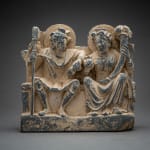Gandhara Schist Relief of Hariti and Pancika, 100 CE - 300 CE
Schist
20.8 x 20.1 cm
8 1/4 x 7 7/8 in
8 1/4 x 7 7/8 in
LK.013
This relief, possibly from a household shrine, depicts the deities Hariti and Pancika. Seated on a double throne, each is portrayed in a relaxed pose as if engaged in conversation....
This relief, possibly from a household shrine, depicts the deities Hariti and Pancika. Seated on a double throne, each is portrayed in a relaxed pose as if engaged in conversation. Both have their divinity emphasized by the inclusion of the nimbus. According to tradition, Hariti, prior to her conversion to Buddhism, was a cruel and vengeful personality. The mother of five hundred sons she nourished them on the flesh of other children stolen from their parents. In order to reveal to Hariti the injustice of her actions the Buddha seized her youngest child. Beside herself with grief Hariti repented and converted to Buddhism. She became associated with motherhood, fertility and prosperity. Often depicted with small children clambering across her lap, this relief shows her other identifying attribute, the cornucopia. The representation of Hariti was apparently conflated with that of the Greek goddess of Fortune, Tyche, who was often depicted with a cornucopia. This kind of interaction between Classical and Buddhist artistic conventions is typical of Gandharan art. Situated on the Silk Road, at the crossroads between East and West, Gandhara has been described by one scholar as a ‘melting pot of cultures.’ Certainly, following its conquest by Alexander the Great in the 4th century B.C., the Greeks exerted an important cultural influence. This continued even after the Greek dynasties were overthrown and the Kushans, from northern China, became established in the first century A.D.
Pancika was Hariti’s consort and traditionally associated with wealth. When the two figures appear together they also symbolise harmony in marriage. Pancika carries his customary attribute, the staff, and previously held something in his left hand which is now unidentifiable. It may have been a money-bag as was customary in such depictions. The staff is very similar to the one adorned with a pine cone (called a thyrsus), which was the attribute of the god of wine Dionysus. He is dressed in a Roman-style tunic rather than an Indian dhoti. The relief is made from grey schist, a material indigenous to Gandhara and extremely popular with local artists. In excellent condition, this sculpture would make a wonderful addition to any collection.
Comparables:
This artefact bears a striking similarity with another schist relief representing the same subject, exhibited at the Museum of Asian Art of Berlin (inv. no. I.1184), dated to the 1st to 3rd century CE.
For a similar but earlier example of this subject in Gandharan art, see Pratapaditya Pal, 'Indian Sculpture: Volume 1,' (1986), p.166.
Pancika was Hariti’s consort and traditionally associated with wealth. When the two figures appear together they also symbolise harmony in marriage. Pancika carries his customary attribute, the staff, and previously held something in his left hand which is now unidentifiable. It may have been a money-bag as was customary in such depictions. The staff is very similar to the one adorned with a pine cone (called a thyrsus), which was the attribute of the god of wine Dionysus. He is dressed in a Roman-style tunic rather than an Indian dhoti. The relief is made from grey schist, a material indigenous to Gandhara and extremely popular with local artists. In excellent condition, this sculpture would make a wonderful addition to any collection.
Comparables:
This artefact bears a striking similarity with another schist relief representing the same subject, exhibited at the Museum of Asian Art of Berlin (inv. no. I.1184), dated to the 1st to 3rd century CE.
For a similar but earlier example of this subject in Gandharan art, see Pratapaditya Pal, 'Indian Sculpture: Volume 1,' (1986), p.166.



